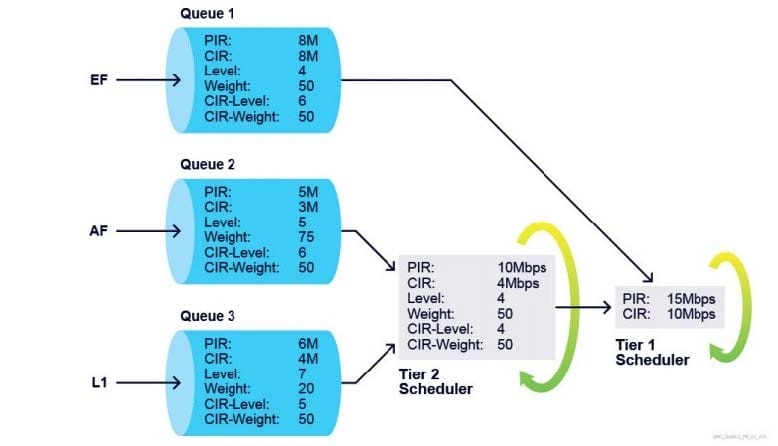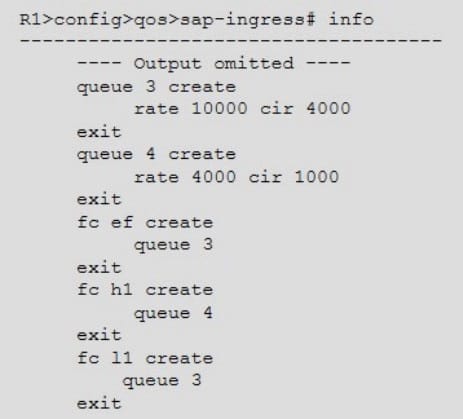Exam Details
Exam Code
:4A0-107Exam Name
:Nokia Quality of ServiceCertification
:Nokia CertificationsVendor
:NokiaTotal Questions
:212 Q&AsLast Updated
:Apr 05, 2025
Nokia Nokia Certifications 4A0-107 Questions & Answers
-
Question 61:
Which of the following statements about marking packets is TRUE?
A. Packets corresponding to a layer-2 service can be pre-marked on SAP-ingress.
B. Packets corresponding to a layer-2 service can be pre-marked on network-ingress.
C. Packets corresponding to a layer-3 service can be pre-marked on SAP-ingress.
D. Packets corresponding to a layer-3 service can be pre-marked on network-ingress.
-
Question 62:
A frame belonging to a Layer 2 service is encapsulated in an MPLS tunnel at a network-egress port. Which of the following fields in the frame can be marked or remarked at the network egress port?
A. ToS
B. DSCP
C. PREC
D. EXP
-
Question 63:
An egress port scheduler applied to an Ethernet port has a configured bandwidth of 100 Mbps. All frames transmitted on the port are 80 bytes. What is the aggregate transmit bandwidth of all queues using the port scheduler?
A. 100Mbps * 20/(80 + 20) = 20 Mbps
B. 100Mbps * 80/(80 + 20) = 80 Mbps
C. 100Mbps
D. 100+ 100 * 20/(80 + 20) = 120 Mbps
-
Question 64:
While deciding how to share the available bandwidth among its children, when does a port scheduler consider the parameter "level" of a child?
A. During the allocation of within-CIR bandwidth.
B. During the allocation of above-CIR bandwidth.
C. During the allocation of both within-CIR and above-CIR bandwidth.
D. The port scheduler does not use the level of a child for making bandwidth allocation decisions
-
Question 65:
Which of the following statements about the bandwidth allocation criteria used by an egress port scheduler is TRUE?
A. The available bandwidth of the port is divided in a strict priority over its children.
B. Expedited queues must be serviced before best-effort queues.
C. Orphaned queues are serviced on the 8th scheduling priority.
D. The configured CIR dictates the maximum port bandwidth that can be allocated during the within-CIR pass for that level.
-
Question 66:
Which of the following components are NOT configured in a hierarchical scheduler policy?
A. Queue parameters with which the queue will compete for bandwidth.
B. The level of hierarchy with which a group of schedulers is associated.
C. Bandwidth controls that limit each child scheduler or child queues associated with the scheduler.
D. The maximum bandwidth that the parent scheduler can offer its child queues or schedulers.
-
Question 67:
Which of the following statements about configuring a hierarchical scheduler policy on a SAP is FALSE?
A. Several Tier 1, Tier 2, and Tier 3 schedulers can be defined within a policy.
B. A queue's parent scheduler must be a Tier-3 scheduler.
C. The parent must have a higher level in the hierarchy.
D. If no parent is configured, the queue/scheduler is considered orphaned.
-
Question 68:
Which of the following statements describes a queue's weight parameter that is used in the hierarchical scheduling?
A. The weight specifies the priority of the queue during scheduling up to its CIR.
B. The weight specifies the priority of the queue during scheduling above-CIR, up to its PIR.
C. The weight is used to determine how this queue and other queues or schedulers at the same CIR-level share available CIR bandwidth at that level.
D. The weight is used to determine how this queue and other queues or schedulers at the same level share available above CIR bandwidth at that level.
-
Question 69:
A hierarchical scheduler policy with the shown parameters is configured at a service ingress. If the offered rate of each queue is 10Mbps, what is the operational PIR and CIR for queue 3?

A. PIR = 5 Mbps, CIR = 0 Mbps
B. PIR= 4 Mbps, CIR = 1 Mbps
C. PIR= 6 Mbps, CIR = 4 Mbps
D. PIR= 6 Mbps, CIR = 1 Mbps
-
Question 70:
An IOM3 card of a Nokia7750 SR is enabled with the default scheduler and the policy shown in the image is applied to an access port on this card. In which order will packets be scheduled out of the queues?

A. Queue 3 within-CIR packets, then queue 4 within-CIR packets, then queue 3 and queue 4 above-CIR packets in round-robin.
B. Queue 4 within-CIR packets, then queue 3 within-CIR packets, then queue 3 and queue 4 above-CIR packets in round-robin.
C. Queue 3 within-CIR packets, then queue 4 within-CIR packets, then queue 3 above-CIR packets, and finally queue 4 above-CIR packets.
D. Queue 4 within-CIR packets, then queue 3 within-CIR packets, then queue 4 above-CIR packets, and finally queue 3 above-CIR packets.
Related Exams:
4A0-100
Nokia IP Networks and Services Fundamentals4A0-101
Nokia Interior Routing Protocols4A0-102
Nokia Border Gateway Protocol for Internet Routing4A0-103
Nokia Multiprotocol Label Switching4A0-104
Nokia Services Architecture4A0-105
Nokia Virtual Private LAN Services4A0-106
Nokia Virtual Private Routed Networks4A0-107
Nokia Quality of Service4A0-108
Nokia Multicast Protocols4A0-109
Alcatel-Lucent Triple Play Services
Tips on How to Prepare for the Exams
Nowadays, the certification exams become more and more important and required by more and more enterprises when applying for a job. But how to prepare for the exam effectively? How to prepare for the exam in a short time with less efforts? How to get a ideal result and how to find the most reliable resources? Here on Vcedump.com, you will find all the answers. Vcedump.com provide not only Nokia exam questions, answers and explanations but also complete assistance on your exam preparation and certification application. If you are confused on your 4A0-107 exam preparations and Nokia certification application, do not hesitate to visit our Vcedump.com to find your solutions here.